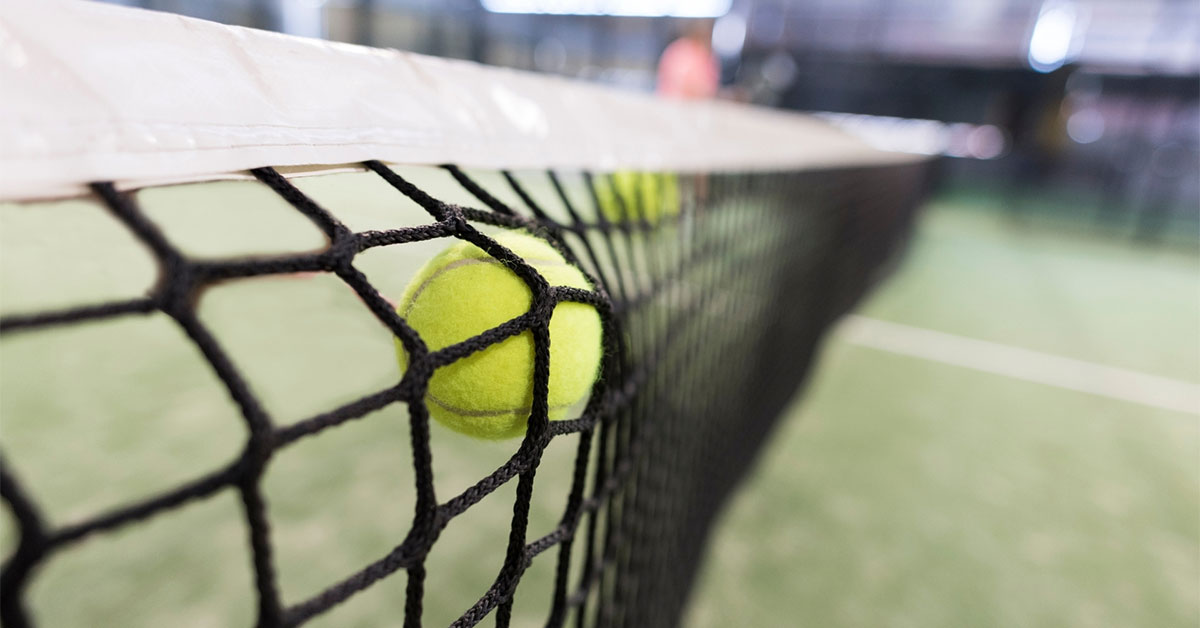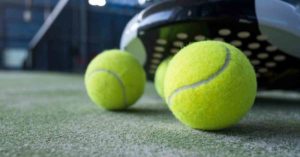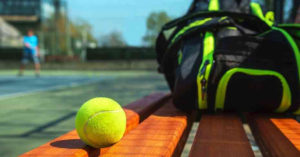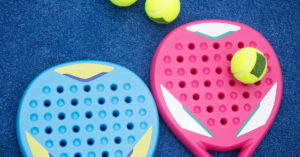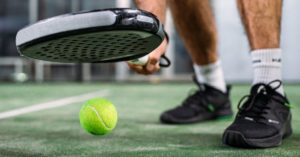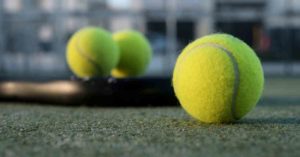You have probably come across the increasingly popular sport Padel. Padel is growing worldwide at a high speed. Padel courts are often found in Tennis clubs. Also, many players practice the sport interchangeably due to their similarities. People will also sometimes refer to Padel Tennis. But, is Padel the same as Tennis?
No, even though Padel has many similar aspects to Tennis, it’s is an entirely unique sport. The court, the balls, and the scoring are the most similar but everything else sets them far apart. In this article, we will explain the biggest difference between both sports.
Various sports can have a lot of common points yet are different from one another. Hence, it comes as no surprise that you’re confused between Padel and Tennis, who are alike in most aspects yet unique in their way.
So, if Padel and Tennis aren’t the same, what factors set them apart?
Table of Contents
The names
As introduced, Padel is sometimes referred to as Padel Tennis, which can be logically explained due to their physical similarities.
There are indeed many sports that are referred to by many names. For example, in Italy, it is not ‘Football’, it is ‘Calcio’. But let’s state it one more time: the one is Padel, the other is Tennis.
Do you know how the name “Padel” came to be? We have written an article about it.
Distinguishing Padel and Tennis, just based on their names is not enough. Therefore, let’s dive into the details.
What is Padel?
At a glance, Padel can be easily described as a fun sport that takes inspiration from both Tennis and Squash. The sport has some very particular elements such as the big transparent and glass walls which also play a role in the game.
- For instance, the ball is allowed to bounce off the glass wall which adds an extra strategical dimension to the game.
- A Padel court is 20m x 10m and surrounded by mesh fencing and glass walls and the surface is often made of artificial grass.
- Padel is mainly played as a 2 vs 2. Each side of the Padel court has two players. The game can be played as a 1 vs 1 but requires a special, smaller court.
- Padel uses thick sturdy rackets, with holes in them
- Padel uses yellow balls, which are almost the same, less bouncy than tennis balls.
- The scoring is exactly the same as tennis
- Padel is still a young and growing sport that has yet to enter into the Olympics.
What is Tennis?
Tennis is a racket sport where a ball is tossed from one player to another within a court. While the description of the sport may seem bland, in reality, it is a game that requires both brain and brawn. Here, one can play Tennis on various types of courts with single and double player options.
- A tennis court is much bigger and completely open, without walls.
- The surface is often made out of artificial grass or clay.
- Tennis can both be played as a 2 vs 2 or as a 1 vs 1 game.
- Tennis uses lightweight string rackets
- Tennis balls use yellow, bouncier balls
- The scoring is exactly the same as padel
- Tennis is an official Olympic sport
I thoroughly enjoy watching the Grand slams. And my most recent favorite champion is none other than Emma Raducanu.
The court
The biggest striking difference between the two types of courts is their design.
Dimensions
The dimension of a Tennis court is larger than a Padel court by a few meters. While the standard Tennis court is long by 23.77m long and 10.97m wide, a Padel court is 20m in length and 10m in width.
Moreover, since a tennis court is completely open, the area a player can use is exponentially bigger as this exceeds the court’s line. Whereas a padel court’s boundaries are the surrounding walls.
The height of the net also differs by a few centimeters. While a Padel court’s net is 0.88 m high in the middle, the top of a Tennis court’s net is higher from the ground at 0.914m.
Walls / no walls
As stated previously, a tennis game requires no walls. However, in Padel, the walls play a significant role in the game.
Glass walls
If you have watched a Padel match, you may have noticed that toughened glass is used, among other materials, as walls on padel courts.
The glass walls are an evolution from previous concrete walls as they allow people and cameras to look inside the court from the outside. This also helped propagate the game internationally thanks to the Crystal Palace design
The glass is a unique kind, specially made for the sport. It is very rare the glass breaks as they are designed to withstand an impact of a body at full speed, even though sometimes, they may fail.
Similarly to Squash, a player can play the ball on the opponent’s wall, after first bouncing on the opponent’s court. And with great strategy, walls can be used as an advantage for gaining points.
Mesh fencing
Approximately, 40% of the remaining surrounding walls are made of mesh fencing. This is the material that you will found at the sides of the court and which also surrounds the entrance and exit.
Mesh fencing plays a role in the game. Although less important than the glass walls, a well placed and correctly played ball on the mesh fencing might confuse your opponent as the bounce is more irregular.
Lines
Padel
Compared to a Tennis court, a padel court ommited a few lines. For instance, you will only find a service line and a central service lines. The surrounded lines have been replaced with walls.

Tennis
A tennis court has many more lines. Next to the service line, the central service line is on a padel court, you will find many more.
For instance, a regular tennis court will have a single line and a double line. This allows the game to be adapted to a 2 vs 2 or 1 vs 1 game.
Also, the baseline plays a much bigger role as this is where a player starts their service. This line, for instance, is replaced by the surrounding walls in padel.
In a Padel match, if the ball goes over the wall, then it is out. But for a tennis match, if the ball goes beyond the inner sideline and baseline, then the receiver gets the point.

Ground
tennis
In Tennis, the three ground options are:
- Clay court, often orange-colored
- Hard court, often blue
- Lawn or grass courts, often crisp green
- Carpet court, often green with red
And each type of ground surface alters the impact of the ball and the movement of the players. Hence, depending on the type of flooring, the players change their gameplay.
Padel
In Padel, you will predominantly find artificial turf. It adds a more rebound effect when the ball hits the floor and enhances player performance. Plus, it is portable.
The other allowed court surfaces are
- Tarmac
- Concrete
- Artificial grass.
The courts can officially come in similar colors to tennis:
- Green,
- Blue
- Terracotta
The rules
Service
Padel
When a Padel player is about to serve, they must stand behind the service line. The serve is done by bouncing the ball once and hitting the ball below the waist.
Their partner can position themselves wherever they find convenient. And, the server should play the service in the area diagonally as opposed to him or her.
Tennis
In Tennis, the serve is played above the head by throwing the ball up. The player should position themselves behind the service line before starting their serve.
As with Padel, they must serve the ball in the area diagonally opposed to themselves. While the service is executed in a double-player match, the other player must stand behind the baseline.
Scoring
The scoring system of a Padel game is the same as the one followed for a Tennis doubles match. Both Tennis and Padel have the same scoring system, these are the thresholds: 0, 15, 30, and 40. The first team that scores the point after 40 wins the game. If both teams are at 40, the game enters into deuce. From Deuce, the first team to be 2 points ahead wins the game
In both Tennis and Padel, the ball cannot bounce twice on the ground.
The particularity for Padel is that the ball can bounce on the glass walls.
And to win points, the players have to make sure their opponents cannot properly playback the ball. There is more similarity than difference in the scoring system.
Out
In Tennis, the ball is considered out when it hits beyond the inner baselines and sidelines. However, in the case of Padel, there are no lines. Instead, it is the wall that determines when the ball is considered out.
This is actually a tactic you can use to win the point. If you smash the ball hard enough so the ball bounces beyond the wall on the opponent’s court, without them being able to return it, you score the point
Intensity
It is not by accident that many retired tennis players turn to padel instead. The game is less prone to injuries as the intensity is lower.
- Balls are mostly played below the waist
- Rallies are often shorter
- Less effort to move the ball
- Less stress on the joints.
With the addition of the glass walls, players have an extra dimension to consider in-game. This creates a more strategic-prone game as opposed to tennis, where a stronger player will often have the upper hand.
And, also, since the game is mainly played with 4 players on a smaller court than tennis, it is much more social which appeals to a lot of older players
Equipment
The various sets of equipment used by players can also help you differentiate one sport from the other. The three essential equipment that differs are-
Rackets
One of the most striking differences you will notice is that a Padel racket is small and thick compared to a tennis racket.
Padel rackets can be made with all kinds of different materials to accommodate the player’s style and comfort. The racket has holes in the head and one has to secure it to their wrist with a strap.
Depending on the brand and quality, the position of these holes will also vary.
A tennis racket, on the other hand, is long and sturdy. And instead of having tiny round holes, they have a thick net that is assembled within the oval frame.
Balls
Like Tennis balls, the only approved colors for a Padel ball is white and yellow. However, Padel balls are tinier than Tennis balls with a size between 6.30 and 6.80cm.
Despite the size, both the balls weigh the same, between 55 and 60g.
There is a good reason why they have this difference, don’t use tennis balls to play Padel
Shoes
With much running around, Tennis shoes are required to be flat with excellent cushioning technology, and depending on the type of court ground, the players will have to choose their footwear carefully.
For a Padel player, stiff soles are preferred. And opting for shoes that enhance flexibility is a better choice. A player can choose from herringbone, Omni, or a hybrid variant. It really depends on one’s level and preference
Conclusion
As we explained, padel is not the same as tennis. Padel draws a lot of inspiration from tennis which we can still recognize in some aspects of the sport but a lot sets them apart too.
It is therefore not strange that both sports have their own governing bodies.
The most striking differences are the different courts and rackets.
A lot of players like to combine both sports as they are quite similar but still strikingly different.

